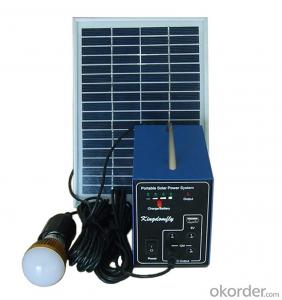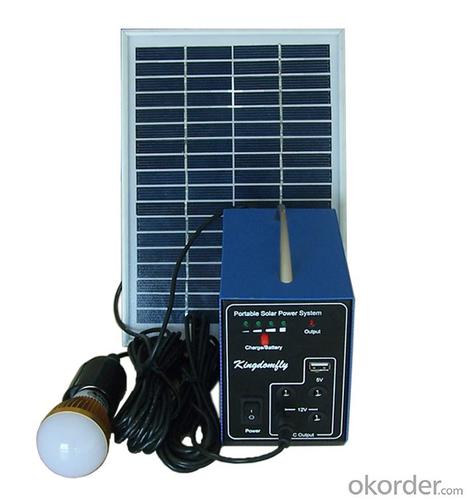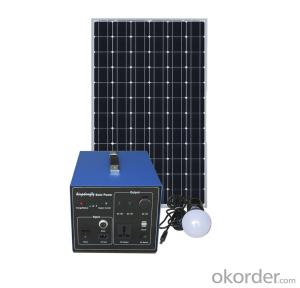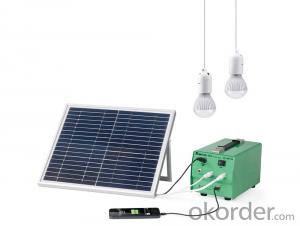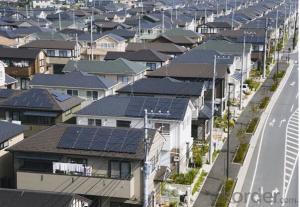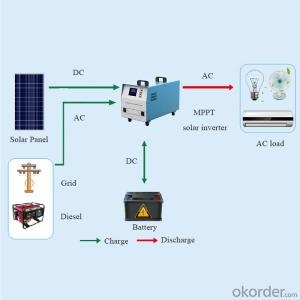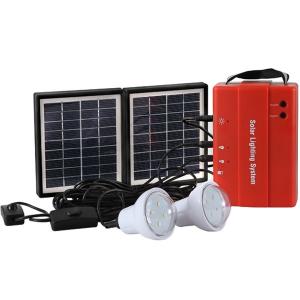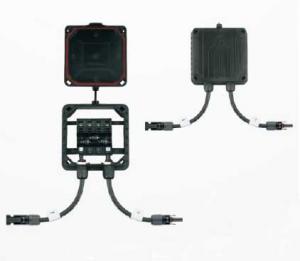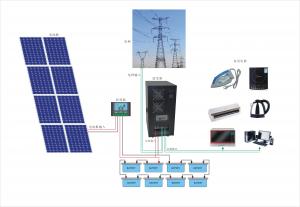Portable Solar Lighting System Hot Selling SPS_5W
- Loading Port:
- China main port
- Payment Terms:
- TT OR LC
- Min Order Qty:
- 3 pc
- Supply Capability:
- 10000 pc/month
OKorder Service Pledge
OKorder Financial Service
You Might Also Like
Main Information
KDF SPS_5W This product is high performance,family used portable solar power system,which can be charged by solar energy on sunny day, and supplies electric power for varies DC electric appliances such as electric fan,lighting lamps, cell charger etc.It is very helpful and useful for home electric supply.
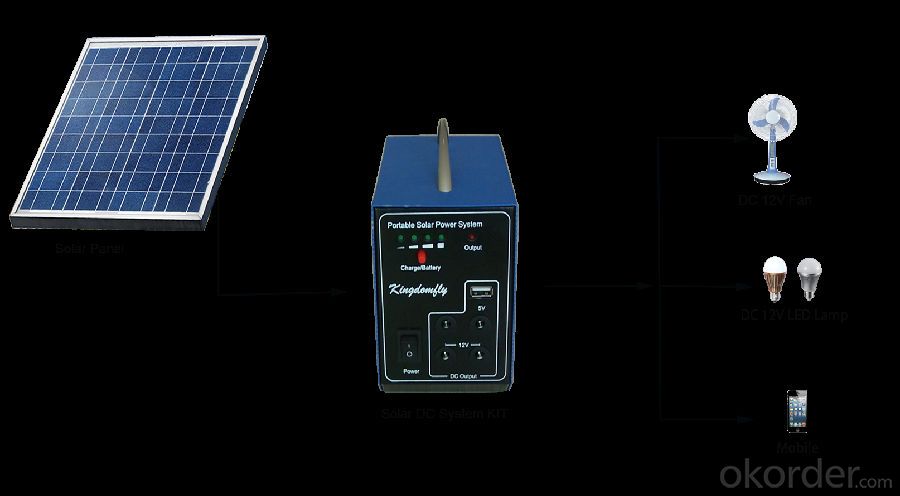
Features:
◆ Low Standby Power Consumption
◆ Solar Feedback Circuit Protection
◆ Output Short-circuit Protection
◆ Small and Portable
◆ Over Charged Protection
◆ Over Discharged Protection
◆ Over Load Protection
◆ Over-Temperature Protection
◆ Easily customized , suitable for Lead Acid Battery or Li Cell
Technical parameters
Specification | Value/Material | |
Item No. KDF | SPS_5W | |
Solar | Specification | Poly silicon |
Working Voltage/Power | 18V5W | |
Battery(Inside) | Specification | Lead Acid |
Rated Voltage/Capacity | 12V4AH | |
Charging Controller | Operating Voltage | 12V |
Input Voltage | 17.3V~21.6V | |
Input current | 5A | |
Power Consumption | 3mA | |
Low Voltage Disconnect(LVD) | 10.8V | |
Low Voltage Reconnect(LVR) | 12.3V | |
High Voltage Discharge( HVC) | 14.6V | |
High Voltage Recharge(HVR) | 13.8V | |
DC Output | DC output & Application | USB 5V1A |
DC output & Application | DC 12V1A*4 | |
SPK Package
Set size | L118*W166*H202mm | Carton Size(6 set) | 387*359*240mm |
Set N·W | 2.9KG | Set N·W | 17.4KG |
Set N·W | 3.8KG | Set N·W | 22.8KG |
- Q: How do solar energy systems impact the electricity transmission infrastructure?
- Solar energy systems can have a significant impact on the electricity transmission infrastructure. As more solar panels are installed, the demand for traditional electricity from the grid decreases, reducing the load on the transmission system. Additionally, solar energy systems generate electricity close to the point of consumption, reducing the need for long-distance transmission lines. However, integrating solar energy into the grid requires upgrades to accommodate two-way power flows and ensure grid stability. Overall, solar energy systems help diversify the energy mix and reduce strain on the transmission infrastructure.
- Q: How does the efficiency of solar panels vary across different panel technologies?
- Solar panels can have varying levels of efficiency depending on the technology used. The market offers several types of solar panels, each with its own unique characteristics and efficiency levels. To begin with, monocrystalline solar panels are renowned for their high efficiency. These panels are constructed from a single crystal structure, resulting in a consistent appearance. Monocrystalline panels achieve the highest efficiency rates, typically ranging from 15% to 22%. The uniform crystal structure facilitates better electron flow, maximizing the conversion of sunlight into electricity. On the other hand, polycrystalline solar panels have lower efficiency when compared to monocrystalline panels. These panels are made from multiple silicon crystals, resulting in a less consistent appearance. Polycrystalline panels generally have an efficiency range of 13% to 16%. The presence of multiple crystals can hinder electron flow, resulting in a slightly lower conversion rate. Another type of solar panel technology is thin-film panels. Thin-film solar panels are created by depositing thin layers of photovoltaic material onto a substrate. These panels exhibit the lowest efficiency rates among the various technologies, typically ranging from 10% to 12%. However, thin-film panels possess the advantage of being lightweight, flexible, and less expensive to produce, making them suitable for certain applications where efficiency is not the primary concern. Additionally, there are emerging technologies such as bifacial solar panels and multi-junction solar cells. Bifacial panels have the ability to capture sunlight from both sides, thereby increasing their overall efficiency. Multi-junction solar cells utilize multiple layers of semiconductors to capture a wider spectrum of light, enabling higher efficiency levels. In conclusion, the efficiency of solar panels varies depending on the panel technology being used. Monocrystalline panels offer the highest efficiency, followed by polycrystalline panels and thin-film panels. Nevertheless, it is crucial to consider other factors such as cost, space availability, and specific application requirements when selecting the most suitable solar panel technology.
- Q: Can a solar energy system be installed in a coastal area?
- Yes, a solar energy system can be installed in a coastal area. In fact, coastal areas can be ideal for solar installations due to the abundance of sunshine and the potential for strong winds, which can help keep the solar panels cool and increase their efficiency. However, it's important to consider the potential impact of saltwater corrosion on the system's components and to use appropriate materials and maintenance practices to ensure its longevity.
- Q: Can solar energy systems be used in powering hotels or resorts?
- Certainly, hotels and resorts can make use of solar energy systems to power their facilities. Solar power is a renewable and clean energy source that can effectively meet the energy requirements of these establishments. Hotels and resorts typically consume a substantial amount of energy for various purposes, such as lighting, heating, cooling, and running electrical appliances and equipment. To harness the abundant sunlight, hotels and resorts can opt to install solar panels on their rooftops or in open areas. This allows them to convert sunlight into electricity, which can then be used to power the entire facility. By doing so, these establishments reduce their dependence on traditional energy sources, resulting in a decreased carbon footprint. In addition to its environmental advantages, solar energy systems can offer financial benefits to hotels and resorts. By generating their own electricity, these establishments can significantly lower or eliminate their utility bills, leading to substantial cost savings in the long run. Furthermore, some countries provide incentives, grants, or tax credits for the implementation of solar power systems, making such installations economically viable. Moreover, the availability of solar energy is not limited to sunny days. With advancements in technology, solar panels can still generate electricity even during cloudy or overcast conditions. Furthermore, any excess energy produced during peak sunlight hours can be stored in batteries for later use, ensuring a steady power supply throughout the day and night. By adopting solar energy systems, hotels and resorts can demonstrate their commitment to sustainability and environmental responsibility. This can serve as a valuable marketing tool, attracting environmentally conscious guests who prefer eco-friendly accommodations. It also aligns with the growing trend of sustainable tourism, enhancing the reputation and competitiveness of these establishments in the industry. Overall, solar energy systems are a practical and efficient solution for powering hotels and resorts. They offer a multitude of benefits, including reduced utility costs, environmental sustainability, and increased market appeal. As technology continues to advance and become more affordable, more hotels and resorts are embracing solar power as a reliable and clean energy source.
- Q: What are the disadvantages of using solar energy?
- One disadvantage of using solar energy is its intermittent nature, as it is dependent on sunlight availability. Factors such as cloudy weather or nighttime can limit its energy generation. Additionally, solar panels and the necessary equipment can be expensive to install, which may deter some individuals or businesses from adopting solar energy.
- Q: Can solar energy systems be used in powering wineries or breweries?
- Certainly, wineries and breweries can utilize solar energy systems to effectively power their operations. Indeed, solar power has been widely embraced by many wineries and breweries worldwide as a sustainable and cost-efficient energy solution. These facilities can install solar energy systems on their rooftops or surrounding areas to capture sunlight and convert it into usable electricity. The electricity generated from solar panels can be employed to power various aspects of winemaking or brewing, including lighting, heating, cooling, and machinery. It can also be used for irrigation pumps and ventilation systems, which are critical for maintaining optimal fermentation conditions. By employing solar power, wineries and breweries not only reduce their carbon footprint and dependence on fossil fuels, but also enjoy several financial advantages. Solar energy systems can significantly decrease utility bills, as these establishments typically require a substantial amount of electricity for their operations. Furthermore, certain regions offer incentives and tax credits to businesses that adopt renewable energy sources like solar power. In addition, solar energy systems provide wineries and breweries with energy independence and reliability. These systems can generate electricity even during power outages or peak demand periods when electricity prices are higher. This ensures uninterrupted production and reduces the vulnerability of these facilities to energy shortages or price fluctuations. Overall, the effectiveness of solar energy systems in powering wineries and breweries has been well-documented, offering environmental, financial, and operational benefits. By harnessing the abundant power of the sun, these industries can contribute to a more sustainable future while enjoying the numerous advantages of solar energy.
- Q: Can solar energy systems be used in conjunction with other renewable energy sources?
- Yes, solar energy systems can be used in conjunction with other renewable energy sources. This combination, known as hybrid renewable energy systems, allows for a more reliable and efficient energy generation. By integrating solar energy with sources like wind or hydro power, the system can compensate for fluctuations in energy production, ensuring a consistent supply of clean and renewable energy.
- Q: Solar power generation system suitable for home, how much is the cost of a set?
- As a new type of clean energy, solar energy has been in a state of high cost due to the purification technology and the price of silicon, but it can not be used in the case where there is no way to connect with electricity
- Q: How do solar energy systems impact the affordability of electricity?
- Solar energy systems can have a significant impact on the affordability of electricity. One of the main benefits of solar energy is that it provides a renewable and abundant source of power. By harnessing the sun's energy, solar systems can generate electricity without relying on fossil fuels, which are subject to price volatility and depletion. This stability in energy costs helps reduce the overall price of electricity. Additionally, solar energy systems can help homeowners and businesses save money on their utility bills. Once installed, solar panels produce electricity at no cost, reducing reliance on grid power and lowering monthly electricity expenses. In some cases, solar energy systems can even generate excess electricity that can be sold back to the grid, further offsetting costs. Moreover, solar energy systems often come with financial incentives and tax credits from governments and utility companies. These incentives can help lower the upfront costs of installing solar panels, making them more affordable for individuals and businesses. As solar technology continues to advance and become more efficient, the cost of equipment and installation has been steadily decreasing, making solar energy systems even more accessible. Overall, solar energy systems positively impact the affordability of electricity by providing a sustainable and cost-effective alternative to traditional power sources. By reducing dependence on fossil fuels, lowering energy bills, and offering financial incentives, solar energy systems play a crucial role in making electricity more affordable for both individuals and society as a whole.
- Q: Can solar energy systems be used in areas with limited access to the electrical grid?
- Areas with limited access to the electrical grid can certainly utilize solar energy systems. In fact, solar power is an ideal option for such areas due to its decentralized nature and sustainability. Photovoltaic panels, for example, capture solar energy and convert it into usable electricity. These systems can be installed in remote locations without extensive electrical infrastructure. By utilizing solar energy systems, areas with limited grid access can become self-sufficient in meeting their energy needs. These systems can power essential appliances like lighting, communication devices, and small-scale machinery, providing reliable energy even in areas where traditional grid connections are unavailable or unreliable. Furthermore, solar energy systems bring numerous benefits to areas with limited grid access. They provide an environmentally friendly alternative to fossil fuel-dependent energy sources, reducing carbon emissions and combating climate change. Solar power systems also offer a consistent and reliable energy source, reducing reliance on expensive and polluting forms of energy like diesel generators. Additionally, solar energy can drive economic growth and development in remote areas. By powering essential infrastructure such as schools, hospitals, and businesses, solar systems improve education, healthcare, and economic opportunities. Moreover, the installation and maintenance of solar energy systems create local jobs and foster entrepreneurship. To successfully implement solar energy systems in areas with limited grid access, it is crucial to address challenges like initial costs, technical expertise, and maintenance. However, advancements in technology and decreasing costs have made solar power increasingly accessible and affordable. Various organizations, governments, and non-profit entities actively work to promote solar energy adoption in such areas and provide necessary assistance. In conclusion, solar energy systems are a viable and sustainable solution for areas with limited access to the electrical grid. They offer a decentralized, reliable, and environmentally friendly source of electricity, bringing numerous benefits to these regions. By harnessing the power of the sun, these systems empower communities, promote economic development, and improve the quality of life for those living in remote areas.
Send your message to us
Portable Solar Lighting System Hot Selling SPS_5W
- Loading Port:
- China main port
- Payment Terms:
- TT OR LC
- Min Order Qty:
- 3 pc
- Supply Capability:
- 10000 pc/month
OKorder Service Pledge
OKorder Financial Service
Similar products
Hot products
Hot Searches
Related keywords
